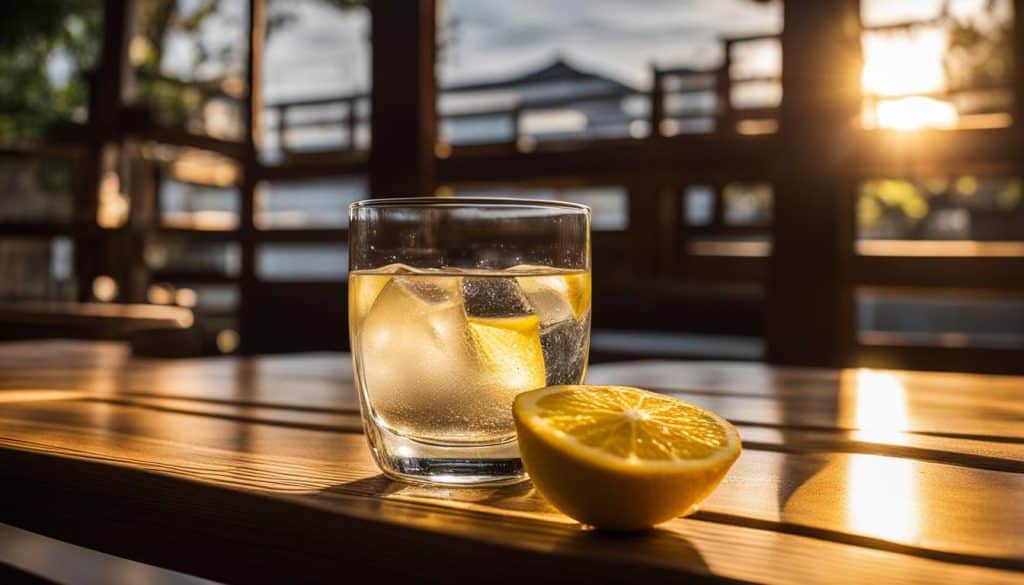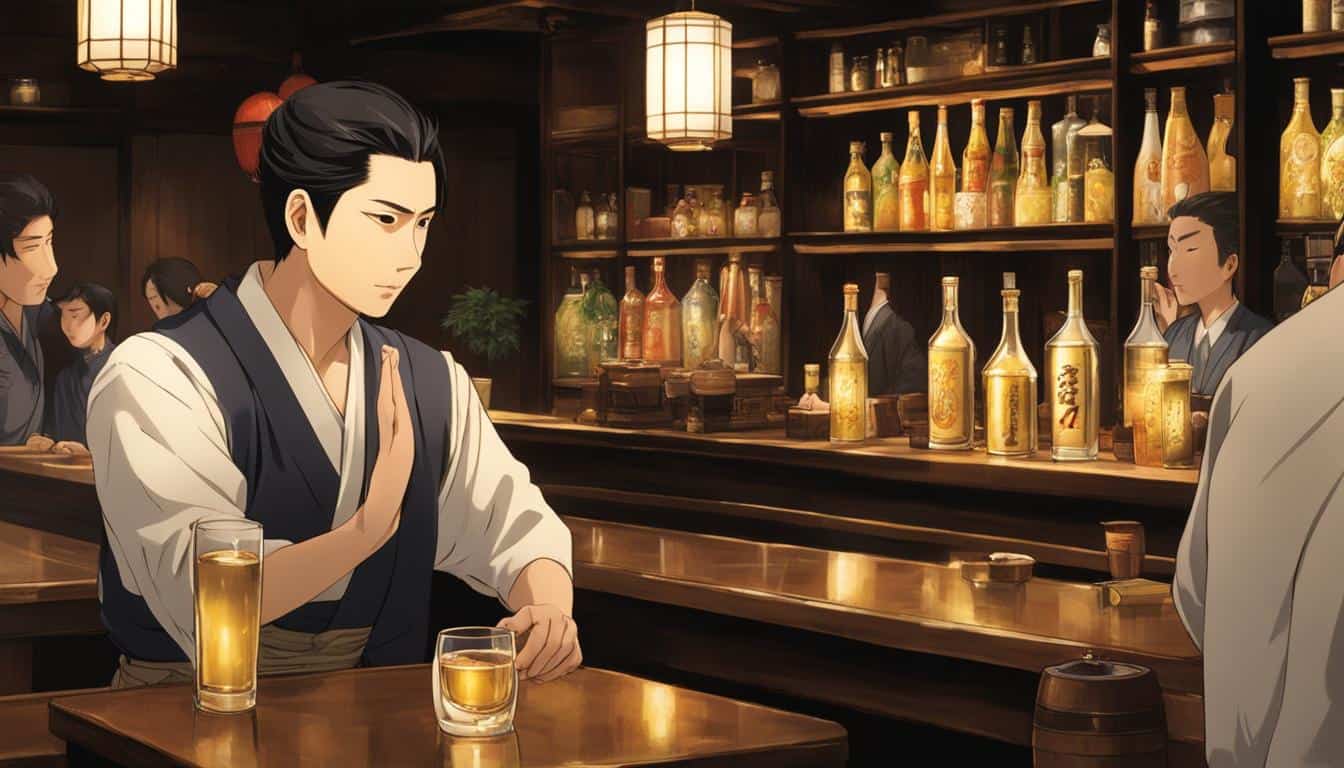Master the Art: A Guide on How to Drink Shochu
To fully savor the exquisite flavors and enticing aromas of shochu, there are various methods to indulge in this delightful spirit. Here, we present five favored techniques for serving shochu:
Key Takeaways:
- There are five preferred methods to serve shochu: straight up, on the rocks, water mixed (mizu-wari), hot water mixed (oyu-wari), and warmed.
- Straight-up is recommended for all otsu-rui shochu, while on the rocks is best for kokuto or mugi shochu.
- Mixing shochu with water (mizu-wari) is ideal for mugi or awamori, and warming shochu is recommended for imo or kome shochu.
- Each method brings out different flavors and characteristics of the shochu, allowing you to enjoy it like a pro.
- Experiment with different methods to find your favorite way to drink shochu.
Straight up – Recommended for all otsu-rui shochu
Straight up is the recommended method for all otsu-rui shochu, which includes types like Imo, kome, and mugi shochu. The key is not to add any water, whether it’s cold or hot so that you can fully experience the unique characteristics produced from the raw materials. Straight shochu is best consumed with a chaser, such as an occasional sip of water. Clean-tasting shochu should be chilled while rich-tasting shochu is best enjoyed at room temperature.
“Straight shochu is a delicious way to immerse yourself in its complex flavors and aromas. By skipping the water, you get a more concentrated taste that showcases the craftsmanship of the distiller. It’s like savoring every note of a fine musical composition. But remember, straight shochu can have a high alcohol content, so it’s important to drink responsibly.
When enjoying straight shochu, it’s crucial to understand the different types of otsu-rui shochu. Imo shochu is made from sweet potatoes, providing a rich and earthy flavor profile. Kome shochu is crafted using rice and has a light and delicate taste. Mugi shochu is made from barley and offers a robust and grainy character. By choosing the right otsu-rui shochu and sipping it straight, you can truly appreciate the intricate flavors and aromas that make this traditional Japanese liquor so unique.
| Type of Otsu-rui Shochu | Taste Profile |
|---|---|
| Imo Shochu | Rich and earthy |
| Kome Shochu | Light and delicate |
| Mugi Shochu | Robust and grainy |
So, the next time you want to immerse yourself in the world of shochu fully, try enjoying it straight up. Whether you prefer the boldness of Imo shochu or the subtlety of kome shochu, each sip will introduce you to a new flavor adventure. Just remember to pace yourself and savor the experience.
On the rocks – Recommended for kokuto or mugi shochu
Shochu served chilled with ice, also known as on the rocks, is a refreshing way to enjoy kokuto or mugi shochu. This method works well for all types of shochu but is especially suited for aged mugi or imo shochu, which have a fruity taste. It is important to use good and transparent ice, preferably made with mineral water or water that has been boiled. Three or four big ice cubes are recommended for the best results.
Chilling the shochu helps to mellow the flavors and aromas, making it a more enjoyable and refreshing drink. The ice also dilutes the shochu slightly, bringing out different nuances in the flavor profile. The cold temperature also numbs the taste buds, allowing for a smoother experience.
When serving shochu on the rocks, it’s essential to choose the proper glassware. A rocks glass or old-fashioned glass is the best choice, as it allows the ice to melt slowly without overcrowding the glass. The shochu should be poured over the ice and stirred gently to help chill the drink evenly.
“The combination of chilled shochu and the subtle flavors of kokuto or mugi shochu make for a delightful drinking experience. The ice adds a refreshing touch and brings out the fruity undertones in the aged shochu.”
To enhance the visual appeal of shochu on the rocks, garnishes such as citrus peels or herbs can be added. These not only add a pop of color but also impart a subtle fragrance to the drink. Experimenting with different garnishes can further elevate the drinking experience and make it more visually appealing.
Table: Best Types of Shochu for Serving on the Rocks
| Type of Shochu | Recommended for On the Rocks |
|---|---|
| Kokuto Shochu | ✔️ |
| Mugi Shochu | ✔️ |
| Imo Shochu | ✔️ |
| Kome Shochu | ❌ |
| Awamori Shochu | ❌ |
*Table showcasing the best types of shochu for serving on the rocks. Kokuto, mugi, and Imo shochu are highly recommended, while kome and awamori shochu are unsuitable.

Water mixed, Mizu-wari – Recommended for mugi or awamori
For those who prefer a milder taste, mixing shochu with water, known as mizu-wari, is the ideal method. Originally, shochu was poured over ice, and water was added right before drinking. However, another way to mix it with water is to let it sit overnight. This allows the molecules of shochu to mix well with the water, resulting in a much softer taste. The usual ratio of shochu to water is 6 to 4 or 5 to 5, and high-quality water with low mineral content should be selected.
Soft water is the key to achieving the perfect mizu-wari. Its gentle and clean taste complements the flavor of the shochu without overpowering it. When choosing water for mizu-wari, opt for high-quality sources such as natural spring water or purified water. Avoid mineral-rich water, as it can interfere with the delicate balance of flavors. The softness of the water allows the true essence of the shochu to shine through, creating a harmonious and enjoyable drinking experience.
When preparing mizu-wari, it’s important to take the time to let the mixture rest. Allowing the shochu and water to meld together overnight allows the flavors to fully develop. This process enhances the smoothness and mellows out any harsh edges, resulting in a more refined and balanced taste. Patience is key when it comes to mizu-wari, as the wait is well worth it for the exquisite drinking experience it provides.
The harmony created by the combination of shochu and soft water in mizu-wari is truly exceptional. The gentle dilution brings out the subtleties of the shochu’s flavors, allowing you to savor them in a more approachable way. Whether you’re a seasoned shochu enthusiast or a newcomer to the world of Japanese spirits, mizu-wari offers a delightful and refreshing way to enjoy this traditional beverage.

The Benefits of Mizu-wari
Mizu-wari offers several advantages that make it an appealing choice for shochu enthusiasts. Firstly, the addition of water helps to lower the alcohol content, making it a more suitable option for those looking to enjoy a longer drinking session. Additionally, the softness of the water enhances the smoothness of the shochu, making it more palatable for those who prefer a milder taste. Lastly, mizu-wari allows the subtle nuances of the shochu’s flavors to shine through, providing a truly immersive sensory experience.
Tips for the Perfect Mizu-wari
- Use high-quality water with low mineral content to ensure a clean and pure taste.
- Let the shochu and water mixture sit overnight to allow the flavors to meld together.
- Experiment with different ratios of shochu to water to find your preferred balance.
- Enjoy mizu-wari with friends and family to enhance the social aspect of drinking shochu.
| Shochu Type | Water Ratio | Recommended Water Type |
|---|---|---|
| Mugi Shochu | 6 parts shochu to 4 parts water | Soft water with low mineral content |
| Awamori | 5 parts shochu to 5 parts water | Soft water with low mineral content |
Warmed – Recommended for imo or kome shochu
If you’re looking for a traditional way to enjoy your Imo or kome shochu, try serving it warmed. This method brings out the unique flavors and aromas of these specific types of shochu. To prepare warmed shochu, mix six parts shochu with four parts water and let it sit overnight to allow the flavors to meld together.
When it comes to heating the shochu, it’s best to use a kuro joka (black pot) with a grill konro (stove) and charcoal or to place the pot in boiling water. Be careful to maintain an ideal temperature of around 113 °F (45 °C), as hotter temperatures can result in a harsh taste. Avoid using the microwave to warm your shochu.
Imo shochu and kome shochu are particularly well-suited for this method, as the gentle warmth brings out their full potential. By following these steps, you can enjoy a soft, mild, and sweet taste that truly captures the essence of warmed shochu. So go ahead and give it a try!
FAQ
How should I drink shochu straight up?
The straight up method is recommended for all otsu-rui shochu. Simply pour the shochu into a glass and drink it without adding any water. This allows you to fully taste the unique characteristics produced from the raw materials used in the shochu.
What is the best way to enjoy shochu on the rocks?
Shochu served chilled with ice, also known as on the rocks, is a refreshing way to enjoy kokuto or mugi shochu. It is recommended to use good and transparent ice made with mineral water or boiled water. Three or four big ice cubes are recommended. This method works well for all types of shochu but is especially suited for aged mugi or imo shochu, which have a fruity taste.
How do I mix shochu with water?
Mixing shochu with water, known as mizu-wari, is ideal for those who prefer a milder taste. You can mix it by pouring shochu over ice and adding water right before drinking. Another way is to let the shochu sit overnight mixed with water, allowing the molecules to mix well and resulting in a softer taste. The usual ratio of shochu to water is 6 to 4 or 5 to 5, and high-quality water with low mineral content should be selected.
What is the traditional way to serve warmed shochu?
Warmed shochu is a traditional way of serving imo or kome shochu. The water and shochu mixture is prepared by mixing them in a ratio of 6 parts shochu to 4 parts water and letting it sit overnight. The warmed shochu is typically heated in a kuro joka (black pot) using a grill konro (stove) with charcoal or by placing the pot in boiling water. The ideal temperature for warmed shochu is approximately 113 °F (45 °C), as hotter temperatures can result in a harsh taste. It is important not to warm shochu in the microwave.


